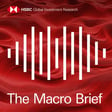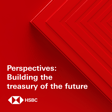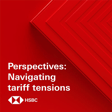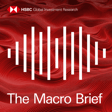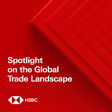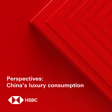Become a Creator today!Start creating today - Share your story with the world!
Start for free
00:00:00
00:00:01

The Macro Viewpoint - China’s great transition, oil price outlook, bond market update
In this edition we look at the shifting growth drivers that will power China’s economy in the years ahead, find out why oil prices look set to stay high over the longer-term and examine some surprising developments in bond market yield curves. Disclaimer.
To stay connected and to access free to view reports and videos from HSBC Global Research click here
Hosted on Acast. See acast.com/privacy for more information.
Transcript
Podcast Introduction
00:00:00
Speaker
This is HSBC Global Viewpoint, your window into the thinking, trends and issues shaping global banking and markets.
00:00:09
Speaker
Join us as we hear from industry leaders and HSBC experts on the latest insights and opportunities for your business.
00:00:17
Speaker
Thank you for listening.
Macro Viewpoint Overview
00:00:22
Speaker
You're listening to the HSBC Global Research Macro Viewpoint, a roundup of our key reports published over the last week by our team of economists and strategists.
China's Economic Shift
00:00:32
Speaker
Coming up today, we discuss the shifting growth drivers that will power China's economy in the years ahead.
00:00:38
Speaker
We find out why oil prices look set to stay high over the longer term and examine some surprising developments in bond market yield curves.
00:00:46
Speaker
This podcast is recorded on Thursday, the 11th of November 2021.
End of China's Real Estate Boom
00:00:51
Speaker
Full disclosures and disclaimers can be found in the link attached to the podcast.
00:00:58
Speaker
Hello, I'm Piers Butler.
00:00:59
Speaker
And I'm Chris Brown-Hulmes.
00:01:01
Speaker
We kick things off in Asia, where our economics team predicts that China's economy is set to undergo a significant transition.
00:01:08
Speaker
Let's get the details now from Xu Hongbin, our chief China economist.
00:01:12
Speaker
Hongbin, thanks for joining us today.
00:01:14
Speaker
Many thanks, Chris.
00:01:15
Speaker
Pleasure to be here.
00:01:16
Speaker
So Hongbin, the starting point for your piece is that the decades-long boom in real estate and infrastructure is coming to an end in China.
00:01:23
Speaker
Why do you feel that?
00:01:24
Speaker
Firstly, if you look at the home ownership,
00:01:27
Speaker
has already reached over 80% across all the cities in China, which is one of the highest in the world.
00:01:34
Speaker
Then more importantly, more than 40% of the household now owes more than two apartments.
00:01:42
Speaker
So the home ownership has really reached kind of limits.
00:01:46
Speaker
And secondly, if you look at basically the housing per capita, it has more than doubled over the last decade.
00:01:53
Speaker
Now in terms of the level, it's one of the highest
00:01:57
Speaker
among all the Asian countries.
00:02:00
Speaker
And also in terms of the demographics, the younger generation is shrinking.
00:02:05
Speaker
So I would suggest that this kind of double-digit growth in China's construction investment has already come to
New Growth Drivers in China
00:02:13
Speaker
the end.
00:02:13
Speaker
And if that is the case, what is going to pick up the slack?
00:02:16
Speaker
There are three new growth drivers that are likely to help to pick up the slack.
00:02:21
Speaker
Firstly,
00:02:23
Speaker
is the capex in the manufacturing sector, particularly the medium to high kind of tech manufacturing.
00:02:31
Speaker
In fact, we already see kind of the credit growth for the manufacturing sector has been accelerating in the recent quarters.
00:02:42
Speaker
At the same time, we also see the scale for labor.
00:02:47
Speaker
The supply has been increased quite rapidly.
00:02:49
Speaker
And also we see Beijing now giving a big push in terms of technology development.
00:02:55
Speaker
So that all points to basically acceleration in the capex manufacturing sector.
00:03:01
Speaker
The second new growth driver is going to be green investment.
00:03:05
Speaker
There is some estimate that in the next 30 years, China needs to invest more than 200 trillion of RMBs
00:03:14
Speaker
into the new clean energy as well as other sectors in order to reach the climate goals in the near term.
00:03:22
Speaker
They need to basically increase the green investment as percentage GDP to over 5%.
00:03:29
Speaker
in the coming years.
00:03:30
Speaker
So that is also going to be a major boost to the investment demand in China.
00:03:37
Speaker
And the third thing that you highlight is the importance of consumption.
00:03:40
Speaker
Yes, there has been a lot of talks about the rebalancing away from investment towards consumption in China in the past, but so far consumption is still relatively steady.
00:03:52
Speaker
But going forward,
00:03:54
Speaker
One of the new forces which is going to push the consumption growth is the expansion of the middle classes.
00:04:02
Speaker
We already see that the scale for labor has been growing quite rapidly.
00:04:09
Speaker
And at the same time, structural reforms try to give the 300 million migrant workers equal opportunities that will also help to expand the middle classes.
00:04:21
Speaker
That, in my view, is going to give more support to the consumption going forward.
China's GDP and Workforce Outlook
00:04:27
Speaker
And what then is this going to mean for overall Chinese growth and employment?
00:04:31
Speaker
In terms of GDP growth rate, of course, growth is going to slow a bit.
00:04:36
Speaker
But still, given all these three new growth drivers, we expect China's GDP growth rate is continuing to remain around 6% in the next three to five years.
00:04:50
Speaker
that, in my view, is going to give them needed kind of support for the kind of job growth in China as well.
00:04:58
Speaker
It all sounds fairly optimistic given the demographic challenges that you mentioned earlier that China is facing.
00:05:04
Speaker
What are the risks to the view?
00:05:06
Speaker
Yes, of course, you know, as you said, demographic, they're in a shrinking, you know, labor force is a new challenge.
00:05:14
Speaker
However, at the same time, we'll also see
00:05:16
Speaker
basically the quality of labor.
00:05:18
Speaker
In other words, the education has been improving.
00:05:21
Speaker
So that helps to offset some of those kind of headwinds.
00:05:26
Speaker
And also at the same time, China is also facing some kind of external challenges.
00:05:31
Speaker
And the most market, particularly the expanding middle class, in my view, is some kind of things which can help China to cope with these new challenges.
00:05:43
Speaker
Hongbin, that's a very helpful summary indeed.
00:05:45
Speaker
Thank you very much for your time.
00:05:47
Speaker
My pleasure.
Oil Price Trends and Global Supply
00:05:51
Speaker
Rising energy prices have been hitting the headlines in recent months.
00:05:54
Speaker
Brent crude oil prices traded in a range for most of the year, but then rose sharply in September.
00:06:00
Speaker
So how does this affect our thinking about the longer term outlook?
00:06:04
Speaker
Gordon Gray is our Global Head of Oil and Gas Equity Research.
00:06:07
Speaker
Gordon, welcome to the podcast.
00:06:09
Speaker
Thanks very much.
00:06:10
Speaker
So firstly, Gordon, bring us up to date in terms of the latest developments on the oil price.
00:06:15
Speaker
The oil price was in a fairly narrow range for much of the year until September, and then it spiked sharply upwards into the mid eighties.
00:06:23
Speaker
And a lot of that was to do with the pull up of commodities in general, particularly the spikes that we saw in, in natural gas and in coal as well.
00:06:32
Speaker
And in the backdrop to all of this is that the OPEC plus group has been increasing production steadily in recent months.
00:06:39
Speaker
There's been pressure on them to produce more and so far they've resisted it.
00:06:43
Speaker
So let's break it down.
00:06:44
Speaker
Firstly, what's happening on the demand side?
00:06:47
Speaker
What's the outlook for that?
00:06:48
Speaker
Well, demand at the moment is extremely strong.
00:06:50
Speaker
We've got a bit of a boost from fuel switching because the gas price in particular is so high.
00:06:54
Speaker
There's maybe a half a million barrels a day of extra demand from switching from gas to oil.
00:07:00
Speaker
But even beyond that, the underlying demand picture is really fairly strong.
00:07:03
Speaker
And we're now looking for demand probably next year to be all the way back to where it was in 2019.
00:07:08
Speaker
And that's still with a lot to come back on the jet fuel side.
00:07:12
Speaker
And then on the other side of the equation is supply, where from your report, it sounds like there are quite a lot of constraints.
00:07:20
Speaker
Well, I think one of the big questions with higher prices is what reacts to those higher prices.
00:07:25
Speaker
And outside of the OPEC group, the most reactive is US tight oil or shale.
00:07:32
Speaker
That's something like 12% of world production.
00:07:34
Speaker
It is starting to show some growth now.
00:07:37
Speaker
Activity in the States has come back with the higher oil price.
00:07:40
Speaker
But yes, it is being hampered to some degree by manpower and other constraints.
00:07:45
Speaker
Nevertheless, we see US growth of something like a million barrels per day next year.
00:07:50
Speaker
Beyond that, outside of OPEC, though, a little bit of a bounce next year, but the longer term picture for other non-OPEC supply we think is flat to down.
00:07:57
Speaker
And so if we put these two parts of the oil price equation together, what's your outlook in the next couple of years?
00:08:04
Speaker
If we look at the reasons oil prices have recovered, I would say, look, demand has recovered quite obviously.
00:08:09
Speaker
But the big factor has been that OPEC cuts nearly 10 million barrels per day off supply last year.
00:08:15
Speaker
Their attitude towards bringing those cuts, bringing that supply back online, being massively conservative ever since mid last year.
00:08:22
Speaker
And it stays conservative.
00:08:24
Speaker
Now, those cuts are unwinding.
00:08:26
Speaker
There will still be a little bit less than 4 million barrels a day of cuts by the end of this year.
00:08:31
Speaker
And there's room for some of that to be unwound next year.
00:08:33
Speaker
But because of that growth in US supply, we don't think all of it will be unwound.
00:08:38
Speaker
But I think there's a bigger issue than that.
00:08:40
Speaker
And that is, as those cuts are unwound, I think they become more and more visible.
00:08:44
Speaker
That spare capacity globally is becoming very limited.
00:08:48
Speaker
And certainly on our estimates, we think global spare capacity could be as low as 3 million barrels a day, maybe even less by the end of next year.
00:08:56
Speaker
Historically, that's a pretty low number and it's a pretty concentrated number within just a very, very few countries.
00:09:03
Speaker
So we think the outlook overall for the oil market is one of reasonable tightness in the medium term.
00:09:09
Speaker
And is that because of underinvestment by the industry?
00:09:13
Speaker
I think to a large degree it is.
00:09:15
Speaker
We're seeing even within the OPEC plus group, we have several countries like Nigeria, Angola, who can't produce at their allocations even after the cuts.
00:09:24
Speaker
And this is because declines in capacity have hit them.
00:09:28
Speaker
But at the global level, yes, we saw something like a 45% drop off in upstream investment relative to the earlier past last decade.
00:09:38
Speaker
As we went into 2020, we've seen a little bit of a pickup now, but investment is still lagging.
00:09:44
Speaker
And I think that investment is affecting not just OPEC members, non-OPEC members as well.
00:09:49
Speaker
And so that's, I think, is driving what will be something of a scarcity of capacity, which will emerge next year, potentially.
00:09:57
Speaker
Gordon, thank you very much.
00:09:58
Speaker
Thank you.
Central Banks and Yield Curve Dynamics
00:10:01
Speaker
We finish this week with a look at the bond markets, where recent central bank actions have had an unusual effect on yield curves.
00:10:08
Speaker
Steve Major, Global Head of Fixed Income Research, joins us now to explain.
00:10:12
Speaker
So, Steve, there's been a lot of activity from central banks recently.
00:10:16
Speaker
Are there any common strands to their thinking?
00:10:18
Speaker
Well, I think most of it is consistent with the idea that if and when rates go up, they don't go up very much.
00:10:25
Speaker
And that's speaking to the lower for longer theme.
00:10:29
Speaker
I mean, central banks haven't been saying that exactly, but it's their actions as much as their words that matter here.
00:10:37
Speaker
And we're talking about what's happened in Australia, the UK, Eurozone and US, all within a few weeks of each other.
00:10:44
Speaker
One of the things we've seen in the bond market this year is a flattening of the yield curve.
00:10:48
Speaker
But the unusual thing is that the short end has risen while the long end has come down.
00:10:52
Speaker
What do you think's behind that?
00:10:54
Speaker
Yeah, the flattening has been a general trend now through most of the year.
00:10:59
Speaker
But what's happened in the last few weeks is very unusual.
00:11:03
Speaker
It's a hard form decoupling whereby yields in the short end, say, for example, the two year have gone up and yields on the 30 year have gone down.
00:11:13
Speaker
whilst in the middle they've moved very little.
00:11:16
Speaker
That's a see-sawing effect.
00:11:17
Speaker
And I think it comes from some de-anchoring going on in places like Australia with the failure to defend the yield curve target.
00:11:28
Speaker
And then the hawkish rhetoric that you've seen in places like the UK that subsequently wasn't followed through on.
00:11:34
Speaker
And other regular speeches from the ECB and the Fed.
00:11:38
Speaker
And you're expecting this trend to reverse.
00:11:41
Speaker
Well, I think it sets up an opportunity and it could be something that starts to work soon or it could take a while.
00:11:48
Speaker
But we're not worried about being too early, better too early than too late on this.
00:11:54
Speaker
The curve is significantly flat.
00:11:57
Speaker
So I'm talking about the historical data here and it's shown by the forwards.
00:12:03
Speaker
So I'm talking about the 10 to the 30 year curve measured in forward terms.
00:12:07
Speaker
So that's something that investors will be noticing.
00:12:10
Speaker
The other thing is the drivers of the curve are going to be what's happening with short rates, which are linked to inflation expectations.
00:12:18
Speaker
If we're right and inflation expectations are peaking, then we'll see some easing pressure at the front end.
00:12:24
Speaker
And that will feed through into a generally steeper curve.
00:12:28
Speaker
So it's a big theme going into next year.
00:12:31
Speaker
Is this just relevant for the US curve or is it broader than that?
00:12:35
Speaker
No, I think it applies everywhere.
00:12:36
Speaker
The US is the biggest and most liquid market.
00:12:39
Speaker
So that's the one we're looking at.
00:12:41
Speaker
We've seen clear evidence of read-across from one to another.
00:12:44
Speaker
There have been days when Australia has been driving global fixed income and even the UK quite recently when it's surprised by not hiking rates, or it surprised many people at least.
00:12:56
Speaker
So it's a global read-across, but the US is the biggest and most liquid fixed income government market.
00:13:03
Speaker
Finally, Steve, where could you be wrong?
00:13:05
Speaker
Well, yes.
00:13:06
Speaker
So if we just go back to the big theme of whether the curve is going to steepen or not, I've already mentioned the timing is one that we could be too early by months on this.
00:13:16
Speaker
But then again, I think the forwards are quite a strong indication.
00:13:20
Speaker
The main risk is that the central banks, like, for example, the Fed especially, are
00:13:26
Speaker
abandon their flexible average inflation targeting, which I think is very unlikely, and it's not our call.
00:13:31
Speaker
But if they did, then they would validate the hawkishness that's been appearing at the front end of the curve, and even more.
00:13:39
Speaker
And the curve would flatten even more than it has done already in a way that would be counter to our view.
00:13:46
Speaker
Steve, thanks very much for explaining that to us.
00:13:48
Speaker
Thank you, Chris.
00:13:52
Speaker
So that's all from us today.
00:13:53
Speaker
Thank you to Chu Hongbin, Gordon Gray and Steve Major for joining us.
00:13:57
Speaker
From all of us here, thanks for listening.
00:13:59
Speaker
We'll be back again next week.
00:14:07
Speaker
Thank you for listening today.
00:14:08
Speaker
This has been HSBC Global Viewpoint Banking and Markets.
00:14:13
Speaker
For more information about anything you heard in this podcast or to learn about HSBC's global services and offerings, please visit gbm.hsbc.com.
